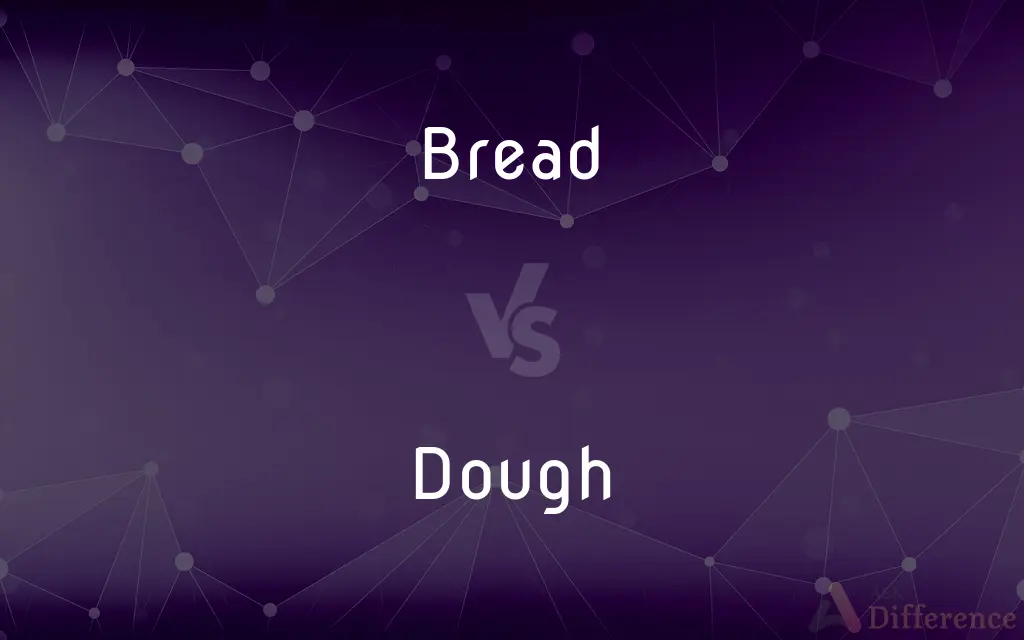Bread vs. Dough — What's the Difference?
Edited by Tayyaba Rehman — By Maham Liaqat — Updated on March 14, 2024
Bread is a baked product, while dough is its unbaked precursor.

Difference Between Bread and Dough
Table of Contents
ADVERTISEMENT
Key Differences
Bread is a staple food prepared from a dough of flour and water, usually by baking. Throughout history and across cultures, bread has been a fundamental part of human diet. On the other hand, dough is the raw mixture made from combining flour, water, and often yeast or other leavening agents, intended for baking into bread or other baked goods.
While dough is the initial state in the bread-making process, undergoing mixing, kneading, and sometimes fermentation, bread represents the final product after the dough has been baked. This baking process causes the dough to rise and solidify, transforming into a fluffy and edible form. Whereas dough is soft and malleable, bread is characterized by its crusty exterior and soft interior.
The ingredients for both bread and dough can be similar—flour, water, yeast, and salt—but the proportions and additional ingredients like sugars, fats, and eggs can vary significantly depending on the recipe. These variations affect the texture, flavor, and appearance of the final bread product.
Dough is versatile and can be used to make a variety of baked goods besides bread, such as pizzas, pastries, and donuts. The distinction lies not only in the ingredients but also in the preparation techniques and the intended final product. Bread, with its countless variations, from sourdough to rye to whole wheat, showcases the remarkable diversity achievable from the simple foundation of dough.
Understanding the transition from dough to bread is essential for bakers and chefs, as it involves mastering the art of kneading, resting, proofing, and baking. This knowledge ensures the dough develops the right texture, flavor, and appearance as it transforms into bread.
ADVERTISEMENT
Comparison Chart
State
Baked product
Unbaked mixture
Ingredients
Flour, water, yeast, salt
Similar, with variations for specific types
Texture
Crusty exterior, soft interior
Soft and malleable
Use
Consumed directly
Prepared for baking
Preparation
Baking
Mixing, kneading, sometimes fermenting
Compare with Definitions
Bread
Baked Good.
Freshly baked bread has a distinctive crusty exterior and a soft interior.
Dough
Wide Range of Goods.
Dough is the base for many baked goods, including pastries and donuts.
Bread
Nutritional Value.
Whole wheat bread is valued for its higher fiber and nutrient content compared to white bread.
Dough
Leavening Process.
Yeast dough rises due to the fermentation process, creating air pockets.
Bread
Cultural Significance.
In many traditions, bread is symbolic of sustenance and community.
Dough
Baking Precursor.
Dough must be properly kneaded before it is left to rise.
Bread
Staple Food.
Bread is often considered a staple food in many cultures around the world.
Dough
Versatile Mixture.
Pizza dough is rolled out thin and topped with sauce and cheese before baking.
Bread
Variety of Types.
Sourdough bread is known for its tangy flavor, achieved through a slow fermentation process.
Dough
Texture and Consistency.
The consistency of dough can vary from sticky and wet to firm and smooth, depending on the recipe.
Bread
Bread is a staple food prepared from a dough of flour and water, usually by baking. Throughout recorded history, it has been a prominent food in large parts of the world.
Dough
Dough is a thick, malleable, sometimes elastic paste made out of any grains, leguminous or chestnut crops. Dough is typically made by mixing flour with a small amount of water and/or other liquid, and sometimes includes yeast or other leavening agents as well as other ingredients such as various fats or flavorings.
Bread
A staple food made from flour or meal mixed with other dry and liquid ingredients, usually combined with a leavening agent, and kneaded, shaped into loaves, and baked.
Dough
A thick, malleable mixture of flour and liquid, used for baking into bread or pastry
Add water to the flour and mix to a manageable dough
Bread
Food in general, regarded as necessary for sustaining life
"If bread is the first necessity of life, recreation is a close second" (Edward Bellamy).
Dough
Money
Lots of dough
Bread
Something that nourishes; sustenance
"My bread shall be the anguish of my mind" (Edmund Spenser).
Dough
A soft, thick mixture of dry ingredients, such as flour or meal, and liquid, such as water, that is kneaded, shaped, and baked, especially as bread or pastry.
Bread
Means of support; livelihood
Earn one's bread.
Dough
A pasty mass similar to this mixture.
Bread
(Slang) Money.
Dough
(Slang) Money.
Bread
To coat with bread crumbs, as before cooking
Breaded the fish fillets.
Dough
A thick, malleable substance made by mixing flour with other ingredients such as water, eggs, and/or butter, that is made into a particular form and then baked.
Pizza dough is very stretchy.
Bread
(uncountable)
Dough
Money.
His mortgage payments left him short on dough.
Bread
A foodstuff made by baking dough made from cereals.
We made sandwiches with the bread we bought from the bakery.
Any leftover bread can be put into the pudding.
Dough
(transitive) To make into dough.
The flour was doughed with a suitable quantity of water.
Bread
Food; sustenance; support of life, in general.
Dough
Paste of bread; a soft mass of moistened flour or meal, kneaded or unkneaded, but not yet baked; as, to knead dough.
Bread
(countable) Any variety of bread.
Dough
Anything of the consistency of such paste.
Bread
Money.
Dough
A flour mixture stiff enough to knead or roll
Bread
Breadth.
Dough
Informal terms for money
Bread
A piece of embroidery; a braid.
Bread
(transitive) To coat with breadcrumbs.
Breaded fish
Bread
To make broad; spread.
Bread
(transitive) To form in meshes; net.
Bread
To spread.
Bread
To cover with bread crumbs, preparatory to cooking; as, breaded cutlets.
Bread
An article of food made from flour or meal by moistening, kneading, and baking.
Bread
Food; sustenance; support of life, in general.
Give us this day our daily bread.
Bread
Food made from dough of flour or meal and usually raised with yeast or baking powder and then baked
Bread
Informal terms for money
Bread
Cover with bread crumbs;
Bread the pork chops before frying them
Common Curiosities
What is bread?
Bread is a baked product made from ingredients like flour, water, and yeast.
How does dough become bread?
Dough becomes bread through the process of baking, which causes it to rise and solidify.
Can dough be used for anything besides bread?
Yes, dough is used to make various baked goods, including pizza, pastries, and donuts.
What are the main ingredients in bread and dough?
The main ingredients include flour, water, yeast, and salt, with variations based on the recipe.
How does the type of flour affect bread?
The type of flour determines the bread's texture, flavor, and nutritional content, e.g., whole wheat vs. white flour.
Is bread healthy?
Bread can be a nutritious part of the diet, especially when made from whole grains, providing fiber and vitamins.
What is proofing in bread-making?
Proofing is the final rise of the shaped bread dough before baking, crucial for developing volume and flavor.
What causes bread to rise?
Yeast fermentation produces gas, causing the bread to rise and develop its texture.
Why does bread have a crust?
The crust forms during baking as the outside of the bread dehydrates and caramelizes, giving it a distinctive texture and flavor.
What is dough?
Dough is an unbaked mixture of flour, water, and often yeast, prepared for baking into bread or other items.
What's the difference between yeast dough and sourdough?
Yeast dough uses commercial yeast for leavening, while sourdough relies on natural fermentation from a starter.
Why is kneading dough important?
Kneading develops gluten, giving the dough its structure and elasticity, essential for the texture of bread.
How do you know when bread is fully baked?
Bread is fully baked when it has a golden crust and sounds hollow when tapped on the bottom.
How long does it take to bake bread?
Baking time varies based on the type of bread, but it typically ranges from 20 minutes to over an hour.
Can bread dough be frozen?
Yes, bread dough can be frozen for later use, though it's best to let it rise first.
Share Your Discovery

Previous Comparison
Puke vs. Vomit
Next Comparison
Melting vs. SmeltingAuthor Spotlight
Written by
Maham LiaqatEdited by
Tayyaba RehmanTayyaba Rehman is a distinguished writer, currently serving as a primary contributor to askdifference.com. As a researcher in semantics and etymology, Tayyaba's passion for the complexity of languages and their distinctions has found a perfect home on the platform. Tayyaba delves into the intricacies of language, distinguishing between commonly confused words and phrases, thereby providing clarity for readers worldwide.
















































